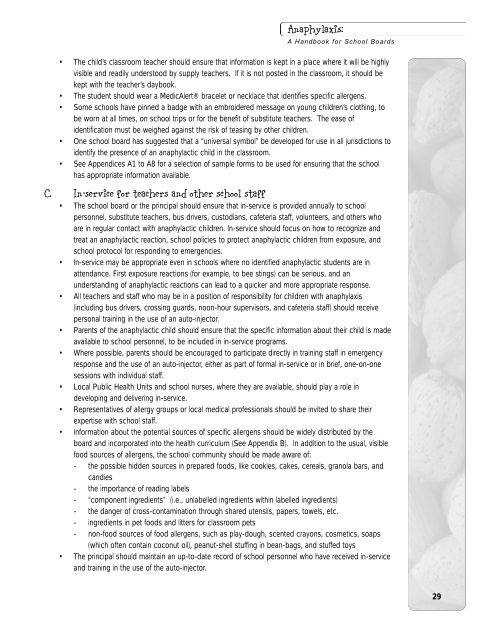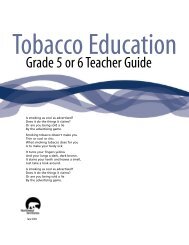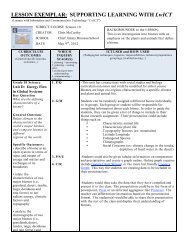Anaphylaxis: A Handbook for School Boards - Education, Culture ...
Anaphylaxis: A Handbook for School Boards - Education, Culture ...
Anaphylaxis: A Handbook for School Boards - Education, Culture ...
Create successful ePaper yourself
Turn your PDF publications into a flip-book with our unique Google optimized e-Paper software.
<strong>Anaphylaxis</strong>:A <strong>Handbook</strong> <strong>for</strong> <strong>School</strong> <strong>Boards</strong>• The child’s classroom teacher should ensure that in<strong>for</strong>mation is kept in a place where it will be highlyvisible and readily understood by supply teachers. If it is not posted in the classroom, it should bekept with the teacher’s daybook.• The student should wear a MedicAlert® bracelet or necklace that identifies specific allergens.• Some schools have pinned a badge with an embroidered message on young children’s clothing, tobe worn at all times, on school trips or <strong>for</strong> the benefit of substitute teachers. The ease ofidentification must be weighed against the risk of teasing by other children.• One school board has suggested that a “universal symbol” be developed <strong>for</strong> use in all jurisdictions toidentify the presence of an anaphylactic child in the classroom.• See Appendices A1 to A8 <strong>for</strong> a selection of sample <strong>for</strong>ms to be used <strong>for</strong> ensuring that the schoolhas appropriate in<strong>for</strong>mation available.C. In-service <strong>for</strong> teachers and other school staff• The school board or the principal should ensure that in-service is provided annually to schoolpersonnel, substitute teachers, bus drivers, custodians, cafeteria staff, volunteers, and others whoare in regular contact with anaphylactic children. In-service should focus on how to recognize andtreat an anaphylactic reaction, school policies to protect anaphylactic children from exposure, andschool protocol <strong>for</strong> responding to emergencies.• In-service may be appropriate even in schools where no identified anaphylactic students are inattendance. First exposure reactions (<strong>for</strong> example, to bee stings) can be serious, and anunderstanding of anaphylactic reactions can lead to a quicker and more appropriate response.• All teachers and staff who may be in a position of responsibility <strong>for</strong> children with anaphylaxis(including bus drivers, crossing guards, noon-hour supervisors, and cafeteria staff) should receivepersonal training in the use of an auto-injector.• Parents of the anaphylactic child should ensure that the specific in<strong>for</strong>mation about their child is madeavailable to school personnel, to be included in in-service programs.• Where possible, parents should be encouraged to participate directly in training staff in emergencyresponse and the use of an auto-injector, either as part of <strong>for</strong>mal in-service or in brief, one-on-onesessions with individual staff.• Local Public Health Units and school nurses, where they are available, should play a role indeveloping and delivering in-service.• Representatives of allergy groups or local medical professionals should be invited to share theirexpertise with school staff.• In<strong>for</strong>mation about the potential sources of specific allergens should be widely distributed by theboard and incorporated into the health curriculum (See Appendix B). In addition to the usual, visiblefood sources of allergens, the school community should be made aware of:- the possible hidden sources in prepared foods, like cookies, cakes, cereals, granola bars, andcandies- the importance of reading labels- “component ingredients” (i.e., unlabelled ingredients within labelled ingredients)- the danger of cross-contamination through shared utensils, papers, towels, etc.- ingredients in pet foods and litters <strong>for</strong> classroom pets- non-food sources of food allergens, such as play-dough, scented crayons, cosmetics, soaps(which often contain coconut oil), peanut-shell stuffing in bean-bags, and stuffed toys• The principal should maintain an up-to-date record of school personnel who have received in-serviceand training in the use of the auto-injector.29
















